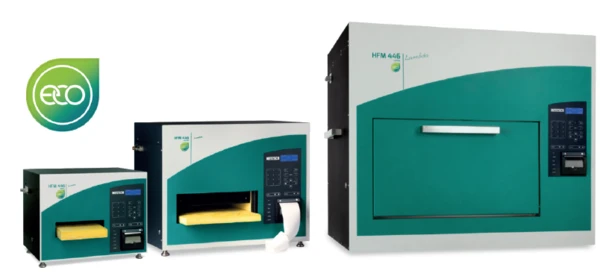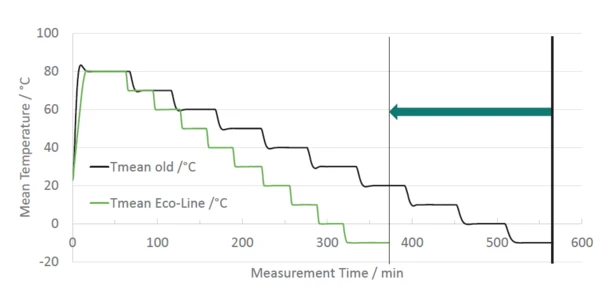
Introduction
The HFM 446 Lambda is a valuable tool for the investigation of the Thermal ConductivityThermal conductivity (λ with the unit W/(m•K)) describes the transport of energy – in the form of heat – through a body of mass as the result of a temperature gradient (see fig. 1). According to the second law of thermodynamics, heat always flows in the direction of the lower temperature.thermal conductivity of insulating materials, which are used for such applications as the thermal insulation of buildings. Better thermal insulation of buildings leads to lower energy consumption for heating in winter and cooling in summer, and thus ultimately to a smaller CO2 footprint.
As a developer and manufacturer of thermoanalytical instruments, NETZSCH also takes the CO2 footprint of its measurement devices into account. One aspect of this is the energy required for the operation of an HFM 446 Lambda at the customer’s site. The energy consumption of the HFM 446 Lambda Eco-Line has been significantly reduced in comparison with that of older models thanks to shorter measurement times on the one hand and energy saved during operation in the so-called Eco Mode on the other. Older models can, of course, be fully upgraded to the Eco-line.
Energy Consumption During a Measurement
Table 1 summarizes the power consumption of the three HFM 446 Lambda instruments (Small, Medium and Large) during a typical measurement on an NIST SRM 1450d fiberboard over the entire temperature range of the HFM 446. The power consumption was measured and recorded using a wattmeter.
Table 1: Mean power consumption of the HFM 446 (measuring unit and chiller) during a measurement on NIST SRM 1450d between 80°C and -10°C mean sample temperature (10 set points, ΔT=20 K).
| Small | Medium | Large | |
|---|---|---|---|
| Measuring Unit [kW] | 0.2 | 0.3 | 0.2 |
| Chiller [kW] | 0.5 | 0.8 | 0.8 |
The total power consumption of the HFM 446 Small is approximately 0.7 kW and that of the HFM 446 Medium and Large approximately 1.0 kW each. The entire annual energy consumptioncan be calculated by finding the power consumption multiplied by the measurement time (see section below) and number of measurements.
Shorter Measurement Times
One of the main advantages of the HFM 446 Lambda Eco-Line is shorter measurement times than older HFM 446 models but with the same accuracy of the results. Reduction of the measurement times is achieved by improved plate temperature control, improved filtering of the heat-flux signals and more sophisticated stability criteria. The shorter measurement time is illustrated in figure 2 which shows a comparison of the transient mean temperature curves of an HFM 446 Lambda Small Eco-Line vs. older models during a Thermal ConductivityThermal conductivity (λ with the unit W/(m•K)) describes the transport of energy – in the form of heat – through a body of mass as the result of a temperature gradient (see fig. 1). According to the second law of thermodynamics, heat always flows in the direction of the lower temperature.thermal conductivity measurement on NIST SRM 1450d between mean sample temperatures of 80°C and -10°C (10 set points, ΔT=20 K). With the Eco-Line version, the entire measurement takes approximately 370 minutes in this case, which is about 200 minutes or 35% faster than the older models.

In general, measurement times, of course, depend on the specimen’s properties, the measurement conditions and the size of the HFM instrument (Small, Medium or Large). Table 2 depicts the mean relative reduction in the measurement time for each instrument type in the HFM 446 Eco-Line for some exemplary samples.
Table 2: Mean relative reduction in measurement times with the new HFM 446 Lambda Eco-Line
| Small | Medium | Large | |
|---|---|---|---|
| NIST SRM 1540d | -35% | -21% | -31% |
| IRMM440 | n.a. | -18% | -30% |
| Pyrex with Instrumentation Kit | -21% | -34% | n.a. |
| VIP | -26% | -36% | -5% |
| cp: solid polymers | -27% | -36% | n.a. |
For standard insulation materials such as 1450d and IRMM440 glass-fiber boards, the amount of time saved is between 20 and 35%. Measurements are faster by up to a third on specimens with higher Thermal ConductivityThermal conductivity (λ with the unit W/(m•K)) describes the transport of energy – in the form of heat – through a body of mass as the result of a temperature gradient (see fig. 1). According to the second law of thermodynamics, heat always flows in the direction of the lower temperature.thermal conductivity, such as Pyrex borosilicate glass, or on products with a very low conductivity, such as Vacuum Insulation Panels (VIP). When measuring the Specific Heat Capacity (cp)Heat capacity is a material-specific physical quantity, determined by the amount of heat supplied to specimen, divided by the resulting temperature increase. The specific heat capacity is related to a unit mass of the specimen.specific heat capacity on solid polymers like PE-HD or POM-C, the reduction in the measurement time can be up to 30%.
The numbers shown in table 2 directly reflect the energy and costs that can be saved for each of these HFM measurements.
However, a direct comparison of the measurement times themselves is not the only aspect which should be considered. For example, with older models of the HFM 446, it was possible to measure one specimen per working day because a measurement having 10 set points lasted in some cases from morning to evening. At the end of such a measurement, the operator is usually no longer in the laboratory and cannot insert the next specimen; thus, a new measurement with which to make use of the remaining hours of the day and night cannot be started. With the faster HFM 446 Eco-Line, it is likely that the same measurement will already be finished in the afternoon and the next specimen can be measured immediately. In this example, not only one, but two specimens can be investigated with the HFM 446 Eco-Line per day, leading to a 100% higher efficiency for such comprehensive long-time measurements.
Idle and Eco Mode
When no measurement is running (standby mode), the HFM Eco-Line can either be in Idle or Eco Mode.
- In Idle Mode, the HFM plate temperatures are held at predefined values, allowing for the quick start of a new measurement at those plate temperatures. The chiller is also running during Idle Mode, with a power consumption of between 0.5 and 1.0 kW.
- In the new Eco Mode, the HFM plate temperature control and chiller are off. Therefore, the energy consumption of the entire system in Eco Mode is almost zero.
The SmartMode software offers a user-defined time schedule as shown in figure 3 to activate either Idle or Eco Mode. When no measurement runs overnight or during the weekend, energy savings in Eco Mode are significant. It should be noted that switching off the chiller via the software, as the Eco-Line instruments do in Eco Mode, was not possible with older models of the HFM 446 Lambda.

Summary
Measurements with the HFM 446 Lambda Eco-Line can be up to 40% faster than older models of the HFM 446. In addition, the so-called Eco Mode allows for switching off the chiller according to a user-defined time schedule when no measurement is running. Depending on the measurement sequences, the two improvements may result in a 100% higher efficiency along with lower electrical energy consumption. The latter does not only correspond to savings in operational costs and – last but not least – contributes to a reduction in CO2 emissions.
It should be noted that older models can, of course, be fully upgraded to the Eco-line. Please ask your local sales representative for an upgrade of your HFM.